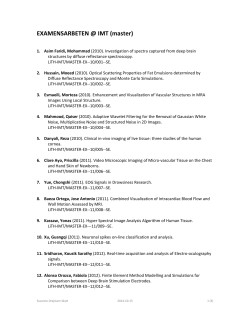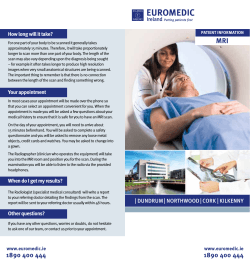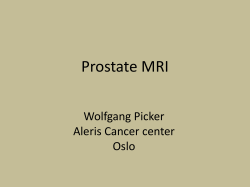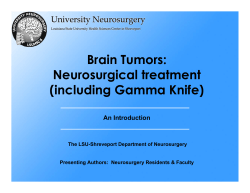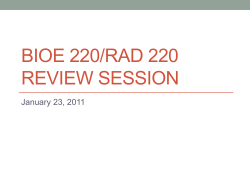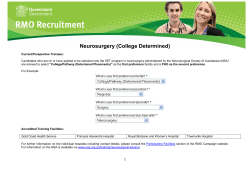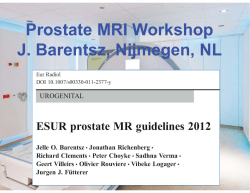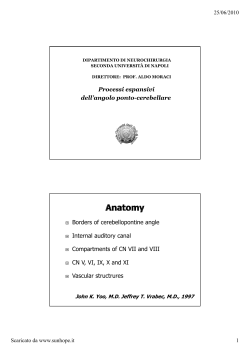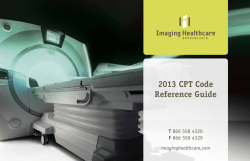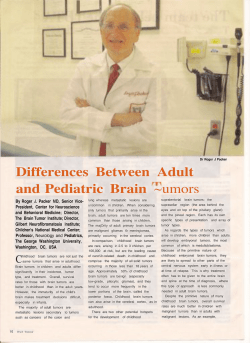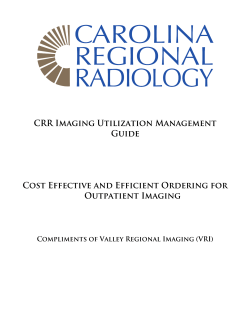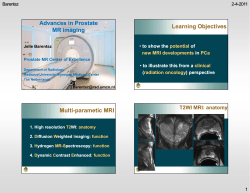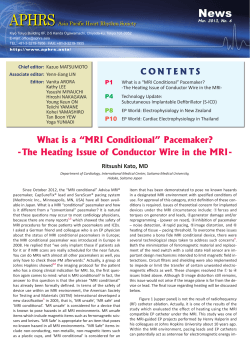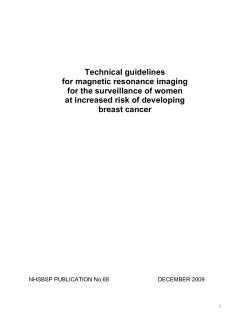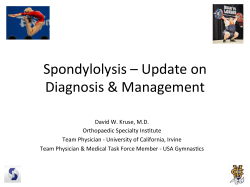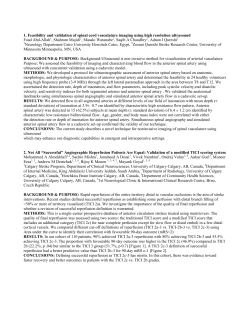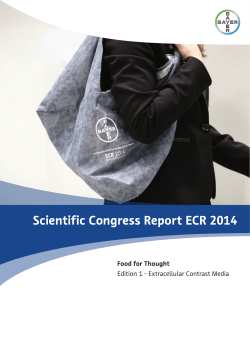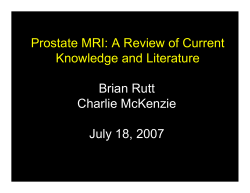
Leading the Way in MRI
Leading the Way in MRI HMRI’s quest for better ways to detect small brain tumors, and to improve diagnostic images of other tumors and of the brain itself, led to our early interest in the prospects for using magnetic resonance in medicine. We established the first clinical Magnetic Resonance Imaging center in Southern California, which was only the fourth in the United States. When we began, MRI was still experimental. We recruited Dr. William G. Bradley to head our MR program. We performed free MRI exams on hundreds of patients who had been referred for routine x-ray CT scans, and then rigorously compared the results, leading to good understanding of the advantages of MRI in various maladies. New knowledge we developed was a major factor in approval of MRI for regular clinical use by the U.S. Food and Drug Administration, and in approval by Medicare and private insurers of payment for the procedure. As part of the MRI program, we established one of the first and best fellowship programs for radiologists who wanted to learn MRI, turning out leaders who went on to run programs throughout Hetero-nuclear MR Virtually all routine MR exams are done by using magnets and radios that are tuned to the resonant frequency of hydrogen ions, or protons. These are abundant and collectively give off relatively strong signals, leading to good diagnostic pictures and well-defined spectra. However, there are other atoms that can reveal other valuable diagnostic Cardiology Southern California, around the United States, and in other parts of the world. Another result of the program was publication of several MRI textbooks, including one that went through several editions. In addition, early MRI radiologists who needed expert “over-reading” in difficult cases were able to consult with HMRI through our teleradiology system, which enabled fast exchange of highresolution sets of MR images for discussion. Teleradiology is now a mainstay of medicine. MR Spectroscopy MRI, CT and many other medical imaging methods show internal details of body anatomy. HMRI recruited Dr. Brian Ross from England to develop MR spectroscopy as a diagnostic tool. Spectroscopy uses the same basic equipment as many anatomical imaging MR scanners, but adds special accessories to allow chemical analysis of metabolic activity in the brain, heart, tumors and other parts of the body. One of the first and most important developments here, the Proton Brain Exam (PROBE), introduced metabolic markers that give neurologists a new tool for determining whether or not a patient is truly in a persistent vegetative state. An example information, and HMRI has had an important role in developing their use. One is carbon, which when labeled can be used to follow details of metabolism not traceable with proton MR spectroscopy. Another is nitrogen, which can be used to follow amino acid and protein changes. Applications include better diagnosis of neurological diseases. is near drowning victims, typically children who have been rescued from water and undergone successful CPR to restore their heartbeat, but still show no sign that their brain functions are intact. With the PROBE exam, doctors can determine whether or not all or most brain cells are still alive. Knowing that they are saves lives by leading to extended life support until the patient awakens, neurologically intact. Another use of MR spectroscopy is to follow glutamate neurotransmitter pathways in the brain. Here Drs. Ross and Keiko Kanamori have conducted a long series of studies on how this compound changes in patients with epilepsy. When Huntington Hospital wanted to launch its internal medicine residency program, it proposed the recruitment of Dr. Richard Bing from Detroit to head it. The Hospital called on HMRI to accommodate his laboratory research so he could continue path-breaking research on cardiac metabolism, vascular physiology and pharmacology, and use of radioactive tracers in diagnosis. With a stellar background at the Carlsberg and Rockefeller Institutes, and at Johns Hopkins, Dr. Bing became widely recognized for studies on how alcohol affects heart muscle metabolism, how drugs including calcium channel blockers work, how the cells lining arteries modulate contraction of the smooth muscles in their walls, and how COX-2 inhibitors like Vioxx can pose an unacceptable risk in some patients. His studies using the intra-vital microscope, that moved to keep tiny arterioles in focus during pulsation, revealed fine details of micro-circulation through high-speed photography. The lab became a center for young cardiologists finishing their residencies in the US, in Europe, and around the world. It was said by many of them that a year’s research fellowship here not only gave them their “BTA” (Been To America), but was indispensible for launching their own careers in research, whether in university hospitals, the pharmaceutical industry or in research institutes. Build on strengths HMRI opened in 1952 to create research opportunities to attract and retain physicians dedicated to improving the current medicine available. Since its inception, our outstanding biomedical and clinical researchers have transformed healthcare and enriched the lives of countless individuals. As we celebrate our first 60 years, we look forward to a future built on a strong foundation of scientific discovery connecting the brightest research minds in the country to the practice of medicine. 734 Fairmount Avenue Pasadena, CA 91105-3104 (626) 397-5804 www.hmri.org Six Decades of Biomedical Discoveries and Development Neurosurgery Research of the American Medical Association, and became very influential. Our prototype safety car based on this research incorporated many of the safety features recommended in the article: raised headrests, strengthened seats, secure door locks, recessed knobs on the dash, and seat belts. The result: increased emphasis on auto safety and hundreds of thousands of lives saved and severe injuries prevented. The Hydrocephalus Shunt “Water-on-the-brain” in children was once virtually untreatable. Drs. Robert Pudenz and William Agnew, working in our labs, established that new formulations of silicone rubber could be made toler- Cancer Cell Biology The advent of computed tomography (CT) x-ray scanners brought the first wave of revolutionary changes to diagnostic imaging of the brain. A challenge was to use the resulting new sensitivity and precision to directly guide neurosurgery. HMRI neurosurgeons and engineers, working with Caltech computer scientists, developed a CT and computer-guided brain surgery system that included a minimally invasive binocular brain endoscope, along with a 3-dimensional display system to help guide surgery. The result: less collateral damage when removing small brain tumors, some about the size of a pea. Early-on, it became apparent to clinicians and laboratory scientists alike that understanding the biology and chemistry of living cells would hold the key to better prevention and treatment of cancer. This led to establishment by Drs. Charles M. Pomerat and Donald E. Rounds of one of the country’s leading tissue culture laboratories, where human cells could be grown in life-like laboratory conditions for experimentation. Studies of smog established that some of its components can lead to lung cancer, and showed how chromosomes become damaged and lead to the abnormal cell division typical of malignancy. Other studies assessed the susceptibility of cancer cells to potential Electrical Stimulation Pioneering Work in Auto Safety Some of HMRI’s deepest roots are in neurosurgery. Drs. Hunter Shelden and Robert Pudenz served together as medical officers heading projects at the U.S. Navy Medical Center Institute of Medical Research in Bethesda, Maryland during World War II. Their studies of traumatic head injuries led to further studies here when they returned to Pasadena. One early project was to have engineers and technicians take apart automobiles from accidents resulting in serious injury or death. The resulting analysis led them to suggest for the first time many of the safety features now common in our cars. The work was published as a lead article in the Journal CT-Guided Brain Surgery able when implanted permanently in patients, and that these materials could be shaped into tubes with valves. This device drained excess fluid from inside the brain into the chest or abdomen, allowing the brain to develop normally instead of expanding the developing skull, or being compressed within it. The result: tens of thousands of childhoods and lives saved to develop normally. Today, in addition to pediatric hydrocephalus, this shunt technology is used to treat some kinds of dementia in older patients whose brains become “waterlogged.” Also, such shunts play a vital role saving lives after trauma or cerebral hemorrhage, when pressure must be relieved in emergencies. HMRI scientists have played a pivotal role in developing electrical stimulation devices, similar in some ways to cardiac pacemakers, but connected to nerves or to the brain itself. The challenge has been to develop electrodes and signaling patterns that are both safe and effective when used for long periods. Building partly on technology developed here for the hydrocephalus shunt, HMRI neuroscientists and engineers developed the most successful nerve electrodes ever designed, which have been incorporated into neural stimulation systems. Example: epilepsy, where some types of seizures can be prevented or stopped early by vagal nerve stimulation (VNS). Thousands of patients treated this way have been able to return to full and productive lives. Cancer Research Our earliest cancer research developed new ways to precede or follow cancer surgery with radiation or chemotherapy, keeping track of outcomes with the area’s first tumor registry, sponsored in part by the National Cancer Institute. Radiotherapy included pioneering therapy with implanted radioactive “seeds,” as well as high-voltage external beam therapy, including the area’s first “cobalt-bomb.” Innovations in chemotherapy included administration prior to surgery to shrink tumor margins and allow more effective surgery. Other innovations included isolated perfusion of powerful drugs, so they circulated only through the blood supply coursing in and around tumors, while reducing damage to the rest of the body. Our affiliated Pasadena Tumor Institute, led by Dr. George Sharp, and our laboratory researchers led southern California in multi-specialty teamwork devoted to cancer, bringing surgeons, radiotherapists, medical oncologists and pathologists together with physicists, pharmacologists, chemists and physiologists to analyze new cases and plan therapy together. Team members served as key faculty members on the cancer services at Los Angeles County General Hospital, at USC and at Loma Linda University. new anti-cancer drugs, and to radiation. One of the ongoing legacies of this program is the PC-3 prostate cancer cell line, now used worldwide. It originated as a metastasis in the bone of a patient of urologist Dr. Lawrence W. Jones, who helped organize our prostate cancer program. In the lab, he worked with Drs. Edward Kaighn, Yasushi Ohnuki and Shankar Narayan to preserve and document PC-3 as an unparalleled high fidelity laboratory model of cancer in the body. An outgrowth of this work is insight into how the slow but inexorable spread of some such cancers can be blocked with new strategies, like blocking their energy metabolism instead of their cell division. First Medical Use of Lasers The high reputation of our cancer physicians and researchers led Hughes Research Laboratories to present their second prototype pulsed ruby laser to us for research. Studies included experimental treatment of disseminated melanoma, which was the first time a laser was ever used in medicine. Drs. Donald E. Rounds and James T. Helsper built on this initial experience both with high-powered lasers for surgery and with an emerging range of gas lasers emitting beams ranging across the color spectrum, each with exciting applications, many of which were pioneered here. One was the first intracellular nano-surgery. Another was advanced work for the U.S. military defining damage thresholds for laser beams, now incorporated into the design of vital protective gear. Work here led to the formation of the Beckman Laser Institute and Medical Clinic at UC Irvine. Biotherapeutics Surgery, radiation and chemotherapy are sometimes inadequate to control cancer. Biological therapy, that is supercharging the body’s own natural defense systems against cancer, offers promise for augmenting standard therapies, and in some cases, for making treatment more gentle, yet still effective. Drs. Marylou Ingram, Skip Jacques and Donald Freshwater pioneered immunotherapy of malignant brain tumors by collecting lymphocytes, which are natural immune cells, from patients, expanding their numbers and tumor-killing potential in our tissue culture lab, and then implanting them back into the sites of brain tumors in patients. Results in more than 200 patients were encouraging and stimulated ongoing efforts to make biotherapeutics an effective 21st century weapon against cancer.
© Copyright 2025
